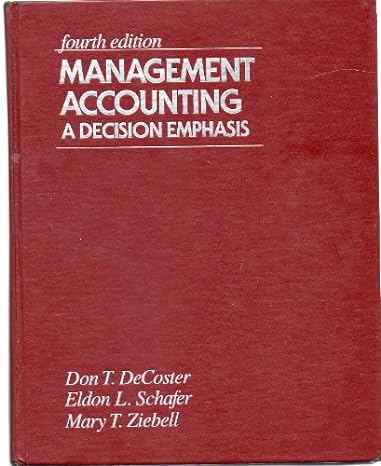Answered step by step
Verified Expert Solution
Question
1 Approved Answer
a. Calculate the standard cost per unit for direct materials and standard rate pe direct labor. (The formulas are given above next to the Direct
a. Calculate the standard cost per unit for direct materials and standard rate pe direct labor. (The formulas are given above next to the "Direct Materials" and "Direct Labor" items. The standard costs that you calculate are the amounts you will use for your flexible budget for each of these costs). b. Prepare a flexible production budget including Revenues, Total Variable Costs, Total Fixed Costs, Total Costs and Net Income, for the three levels of activity (number of units to break even, number of units to achieve a $25,000 profit, number of units to achieve a $40,000 profit). The CEO is convinced of the Director of Sales' ability to achieve a profit of $40,000 a month and reports those costs on the company's static budget. However, actual sales for the first month were 12,900 units. The actual revenues and expenses for the month were: VARIABLE COSTS (per unit) Sales: $237,457 Direct Materials: $15,200 Direct Labor: $58,050 Indirect Materials: $1,305 Indirect Labor: $2,200 Utilities for Factory: $8,900 Supplies for Factory: $1,925 Variable Sales Commissions: $14,760 FIXED COSTS (per month) Factory Supervisor Salaries: $43,000 Factory Depreciation: $15,500 Property Taxes (Factory): $4,500 Insurance (Factory): $3,500 Maintenance (Factory): $1,860 Fixed Sales Salaries $10,000 Depreciation, Sales Equip. $12,250 Advertising $5,720 1. Prepare a report showing the revenue and spending and activity variances for each cost, including total and net income amounts. (Remember, you will need to prepare a flexible budget for the actual level of activity in order to complete this report.) 2. Based on your report, answer the following: a. Look at the Revenue Variance in conjunction with the Selling Expense variances. What is a possible explanation for these variances? b. Are the Activity Variances mostly favorable or unfavorable? Is this a good thing? What do activity variances tell us about the company's performance? c. What do you notice about the FIXED activity variances? Why is this the case? d. What do the Direct and Indirect Materials spending variances indicate about the company's use of materials? e. What do the Direct and Indirect Labor spending variances indicate about the company's laborers? f. Overall, how well did the company perform in the first month with regard to sales of the Whack-O? The CEO of Baxter Company is particularly concerned about the Direct Materials and Direct Labor spending variances and asks the Production Manager to further investigate what caused them. Upon further review, it was determined that the company purchased 40,000 pounds of raw materials in the first month at a cost of $.38 a pound. All of the materials purchased were used to make the 12,900 units produced that month. The standard materials quantity and cost for each unit is 3 pounds per unit at a cost of $.50 per pound. Additionally, it was discovered that the direct laborers spent, on average, 30 minutes on each product and were paid a rate of $9.00 per DL hour. The standard activity is 20 minutes per product at a rate of $12.00 per DL hour. Total (variable plus fixed) manufacturing overhead was applied at a rate of $20.85 per direct labor hour. The Production Manager thought that he had done a good job of containing the material and labor costs for the month and was surprised that the CEO was concerned about the production costs. 1. Compute the following variances: a. Materials Price Variance (AQ X AP) vs (AQ X SP) b. Materials Quantity Variance. (AQ X SP) vs. (SQ X SP) c. Labor Rate Variance. (AH X AR) vs (AH X SR) d. Labor Quantity (Efficiency) Variance (AH X SR) vs. (SH X SR) e. Total Overhead Variance (Actual MOH vs Applied MOH). *Hint: The net of each price/quantity variance for DM and DL should equal your spending variance for each item. 2. Looking at these variances as a whole, what are some possible explanations as to what caused these variances? (Your answer must include possible explanations for each of the labor/materials variances). What are some things management can do to improve these variances
Step by Step Solution
There are 3 Steps involved in it
Step: 1

Get Instant Access to Expert-Tailored Solutions
See step-by-step solutions with expert insights and AI powered tools for academic success
Step: 2

Step: 3

Ace Your Homework with AI
Get the answers you need in no time with our AI-driven, step-by-step assistance
Get Started


